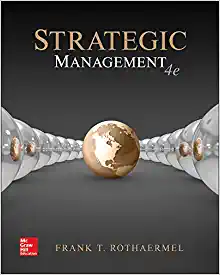In many situations, promising ideas emerge from the lower levels of an organization, only to be discarded
Question:
In many situations, promising ideas emerge from the lower levels of an organization, only to be discarded before they can be implemented. It was only extraordinary tenacity and disregard for the policy of selling only corporate-approved drinks that permitted the Frappuccino to “bloom” within Starbucks (see Strategy Highlight 2.1). Some scholars have suggested that companies set aside up to 2 percent of their budgets for any manager with budget control to be able to invest in new ideas within the company.73 Thus, someone with a $100,000 annual budget to manage would be able to invest $2,000 in cash or staff time toward such a project. Multiple managers could go in together for somewhat larger funds or time amounts. Through such a process, the organization could generate a network of “angel investors.” Small funds or staff time could be invested in a variety of projects. Approval mechanisms would be easier for these small “seed-stock” ideas, to give them a chance to develop before going for bigger funding at the top levels of the organization. What problems would need to be addressed to introduce this angel-network idea into a firm? Use a firm someone in your group has worked for or knows well to discuss possible issues of widely distributing small funding level approvals across the firm.
Data from Strategy Highlight 2.1
Diana, a Starbucks store manager in Southern California, received several requests a day for an iced beverage offered by a local competitor. After receiving more than 30 requests one day, she tried the beverage herself. Thinking it might be a good idea for Starbucks to offer a similar iced beverage, she requested that headquarters consider adding it to the product lineup. Diana had an internal champion in Howard Behar, then a top Starbucks executive. Behar presented this strategic initiative to the Starbucks executive committee. The committee voted down the idea in a 7:1 vote. Starbucks CEO Howard Schultz commented, “We do coffee; we don’t do iced drinks.” Diana, however, was undeterred. She experimented until she created the iced drink, and then she began to offer it in her store. When Behar visited Diana’s store, he was shocked to see this new drink on the menu—all Starbucks stores were supposed to offer only company-approved drinks. But Diana told him the new drink was selling well. Behar flew Diana’s team to Starbucks headquarters in Seattle to serve the iced-coffee drink to the executive committee. They liked its taste, but still said no. Then Behar pulled out the sales numbers that Diana had carefully kept. The drink was selling like crazy: 40 drinks a day the first week, 50 drinks a day the next week, and then 70 drinks a day in the third week after introduction. They had never seen such growth numbers. These results persuaded the executive team to give reluctant approval to introduce the drink in all Starbucks stores. You’ve probably guessed by now that we’re talking about Starbucks Frappuccino. Frappuccino is now a multibillion-dollar business for Starbucks. At one point, this iced drink brought in more than 20 percent of Starbucks’s total revenues, which were $23 billion in 2017.
Step by Step Answer:






